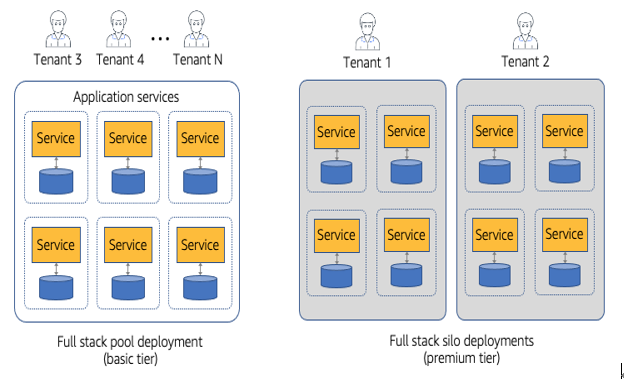A Hybrid Full Stack Deployment Model
So far, I’ve mostly presented full stack silo and full stack pool deployment models as two separate approaches to the full stack problem. It’s fair to think of these two models as addressing a somewhat opposing set of needs and almost view them as being mutually exclusive. However, if you step back and overlay market and business realities on this problem, you’ll see how some organizations may see value in supporting both of these models.
Figure 3-10 provides a view of a sample hybrid full stack deployment model. Here we have the same concepts we covered with full stack silo and pool deployment models sitting side-by-side.

Figure 3-10. A hybrid deployment model
So, why both models? What would motivate adopting this approach? Well, imagine you’ve built your SaaS business and you started out offering all customers a full stack pooled model (shown on the left here). Then, somewhere along the way, you ran into a customer that was uncomfortable running in a pooled model. They may have noisy neighbor concerns. They may be worried about some compliance issues. Now, you’re not necessarily going to cave to every customer that has this pushback. That would undermine much of what you’re trying to achieve as a SaaS business. Instead, you’re going to make efforts to help customers understand the security, isolation, and strategies you’ve adopted to address their needs. This is always part of the job of selling a SaaS solution. At the same time, there may be rare conditions when you might be open to offering a customer their own full stack siloed environment. This could be driven by a strategic opportunity or it may be that some customer is willing to write a large check that could justify offering a full stack silo.
In Figure 3-10, you can see how the hybrid full stack deployment model lets you create a blended approach to this problem. On the left-hand side of this diagram is an instance of a full stack pooled environment. This environment supports that bulk of your customers and we label these tenants, in this example, as belonging to your basic tier experience.
Now, for the tenants that demanded a more siloed experience, I have created a new premium tier that allows tenants to have a full stack silo environment. Here we have two full stack siloed tenants that are running their own stacks. The assumption here (for this example) is that these tenants are connected to a premium tier strategy that has a separate pricing model.
For this model to be viable, you must apply constraints to the number of tenants that are allowed to operate in a full stack silo model. If the ratio of siloed tenants becomes too high, this can undermine your entire SaaS experience.
